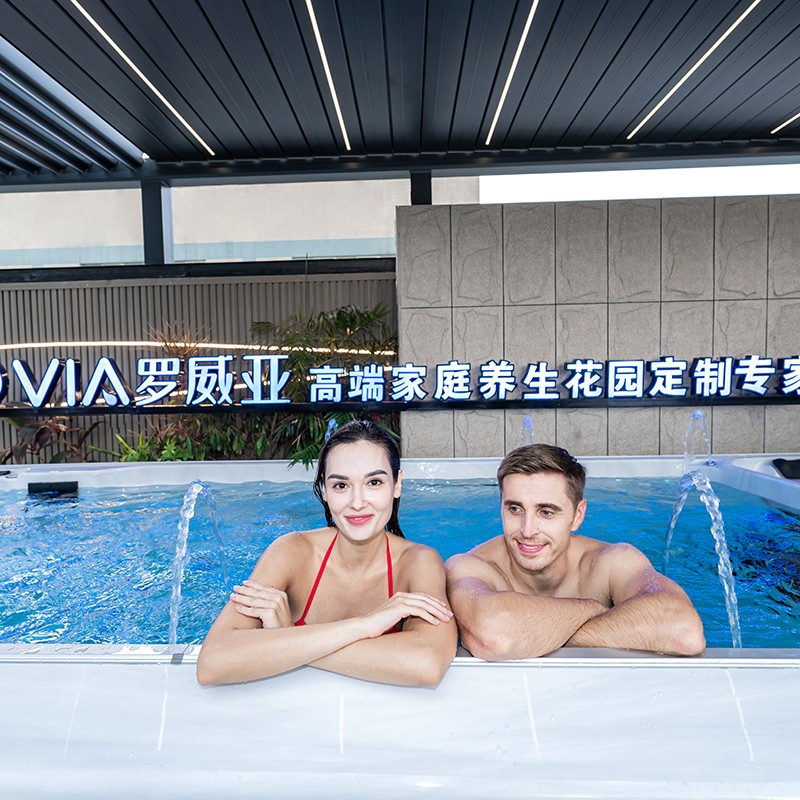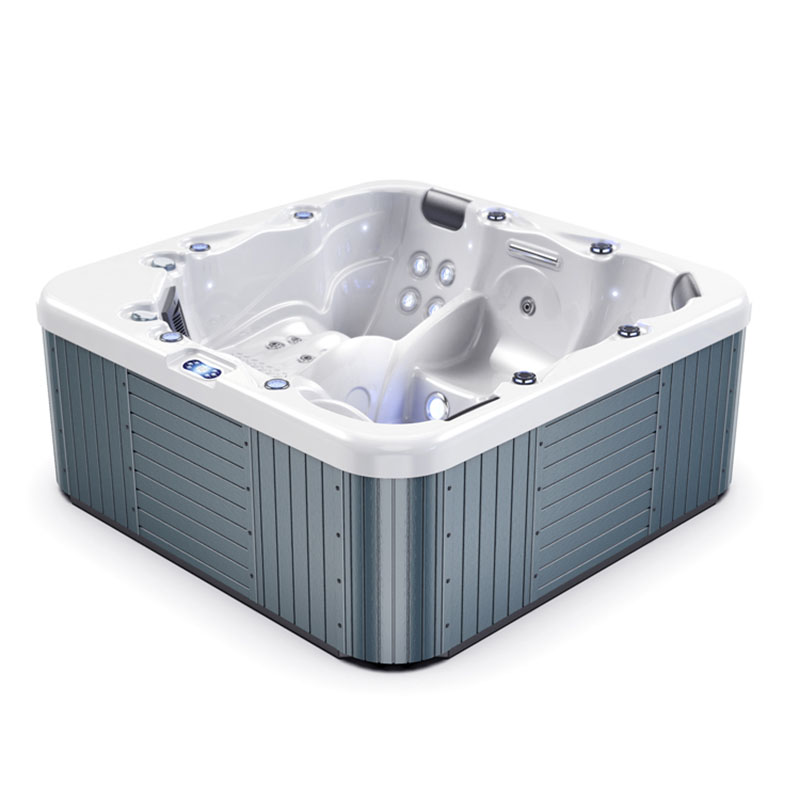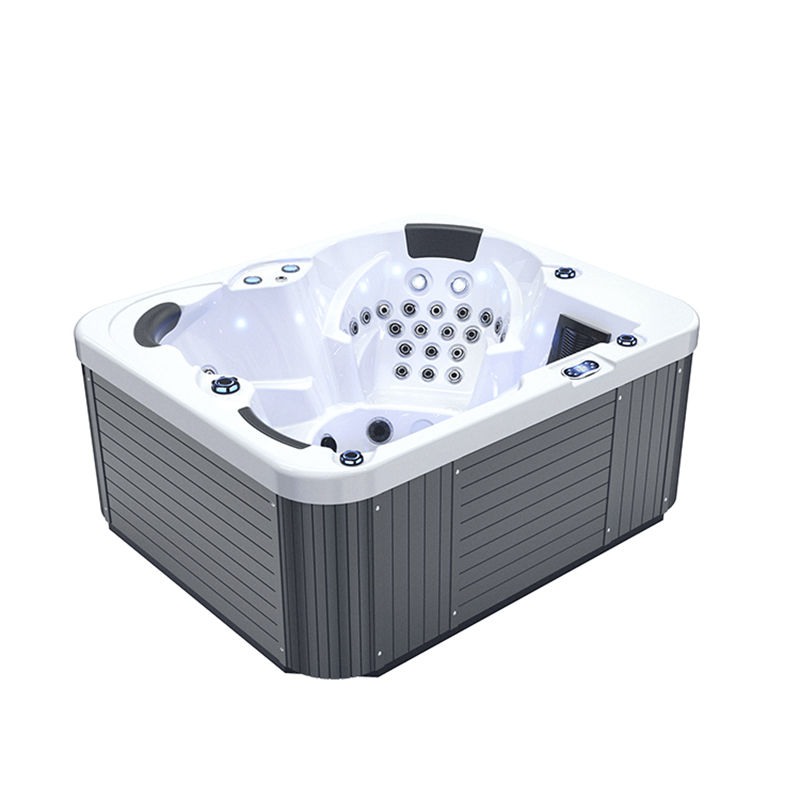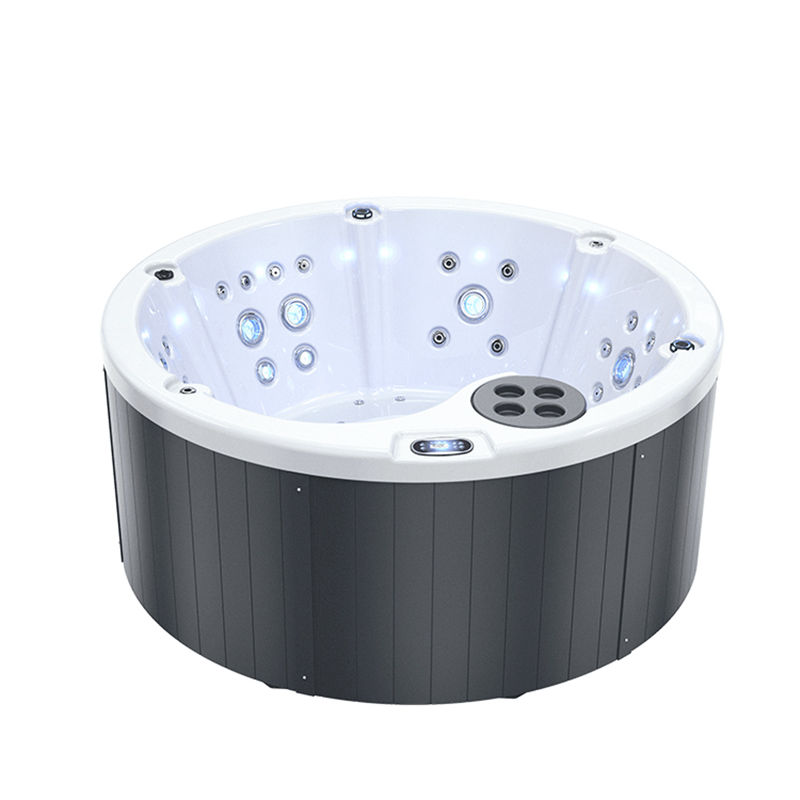O local de instalação e as condições ambientais também são fatores importantes que determinam o consumo de energia.1. Banheiras de hidromassagem para uso externoenfrentam maiores perdas de calor e flutuações de temperatura. O aquecimento torna-se mais difícil no inverno e é necessária energia adicional no verão para manter uma temperatura adequada da água.
2. Banheiras de hidromassagem para instalação em ambientes internos

Embora menos afetado pela temperatura do ar, a má ventilação e o aumento da umidade obrigam o sistema de desumidificação a funcionar com frequência, aumentando indiretamente o consumo de energia.
Em contraste,
banheiras de hidromassagem
São menores, possuem calor concentrado e tempos de operação mais curtos, o que facilita o controle da temperatura e, consequentemente, resulta em menor consumo de energia.
Para reduzir o consumo de energia, as banheiras de hidromassagem devem ser equipadas com isolamento, coberturas à prova de vento e resistentes, e deve-se escolher um local de instalação bem ventilado.
Por que a própria atividade de natação aumenta o consumo de energia?
A característica mais marcante de uma banheira de hidromassagem é a possibilidade de nadar no mesmo lugar.
No entanto, essa característica também representa uma fonte significativa de consumo de energia.

Para gerar fluxo de água suficiente para um adulto nadar no mesmo lugar, o sistema precisa acionar continuamente uma bomba de água de alta potência e manter uma vazão estável.
Normalmente, no modo de natação, cada bomba pode atingir de 3 a 5 cavalos de potência, e a potência total quando várias bombas estão funcionando simultaneamente pode até ultrapassar 10 cavalos de potência.
As banheiras de hidromassagem, por outro lado, não possuem esse recurso, e suas bombas normalmente consomem menos de um terço da energia total.
Portanto, sempre que a função de natação é ativada, o consumo instantâneo de energia de uma banheira de hidromassagem aumenta exponencialmente.
Como reduzir o consumo de água e eletricidade ao usar uma banheira de hidromassagem?
Embora as banheiras de hidromassagem sejam inerentemente intensivas em energia, o consumo de água e eletricidade pode ser reduzido de forma eficaz através do uso e manutenção adequados:
• Instale revestimentos isolantes de alta eficiência e estruturas à prova de vento para reduzir a perda de calor;
• Mantenha a temperatura da água constante e evite flutuações frequentes de temperatura;
• Limpe regularmente o filtro e a tubulação para manter o sistema de fluxo de água eficiente;
• Desligue a bomba de água e o sistema de aquecimento quando não estiverem em uso;
• Utilize modos de circulação que economizam energia para manter a qualidade da água, em vez de operação contínua de alta intensidade;
• Escolha lâmpadas LED com baixo consumo de energia e sistemas de controle eletrônico de baixa potência;
• Controlar adequadamente a frequência das trocas de água para reduzir a vazão, garantindo ao mesmo tempo a qualidade da água.
Por meio de uma gestão científica, mesmo as banheiras de hidromassagem com alto consumo de energia podem alcançar um equilíbrio entre desempenho e eficiência energética.
Que testes de qualidade são realizados antes do envio?
Antes do envio, cada spa LOVIA passa por testes de estanqueidade, inspeção de isolamento e verificação de segurança elétrica. Nossa equipe de controle de qualidade segue os procedimentos da ISO 9001 para garantir que cada spa atenda aos padrões de exportação. Os compradores recebem relatórios de inspeção detalhados e a opção de testes por terceiros. Como fabricante de alta qualidade, nos orgulhamos da entrega sem defeitos e do desempenho duradouro.
In contrast, the massage jets in a hot tub have lower power and operate for a much shorter time.
Therefore, the water flow system alone can consume 3 to 5 times more electricity than a hot tub.
Why is there such a significant difference in energy consumption for the heating system?
Heating is one of the primary sources of energy consumption in a swim spa tub.
While both require maintaining a constant water temperature, the difference in water volume and heating efficiency means that the swim spa tub consumes significantly more energy for heating.
1. Larger water volume, longer heating time
The water volume in a swim spa tub is often 4 to 6 times that of a hot tub. Heating such a large volume of water from room temperature to 38°C naturally requires significantly more energy.
2. Larger heat loss area
Swim spa tubs are typically installed outdoors or semi-outdoors, with a large water surface area, making heat easily lost through evaporation and air convection.
Without high-quality insulation covers or windproof measures, the heating system must repeatedly start and stop to maintain the temperature, resulting in additional energy consumption.
3. Multi-zone heating design
Some high-end swim spa tubs use independent heating systems for the swimming and massage zones, allowing for separate temperature control.
While this improves comfort, it also means maintaining the thermal balance of two different water zones simultaneously, further increasing energy consumption.
Therefore, in terms of heating efficiency and heat retention, swim spa tubs are inherently more energy-intensive than hot tubs.

Why does the filtration and circulation system also increase energy consumption?
The larger volume of water in a swim spa tub means more impurities, skin flakes, makeup residue, and even airborne dust can enter the water.
To maintain water quality, the system must run the filtration system frequently.
• Hot tub: The filtration pump only needs to run for a few hours a day to purify the water.
• Swim spa tub: To maintain water flow and clarity, the circulation pump operates almost 24/7, keeping the water flowing even when not in use.
Furthermore, the high-flow pump, ozone sterilization device, and ultraviolet purification system in the filtration system also continuously consume electricity.
While these devices ensure hygiene, they also make the energy consumption of a swim spa tub significantly higher than that of a hot tub.
Why is a swim spa tub more prone to water waste?
Besides electricity consumption, swim spa tubs are also more wasteful in terms of water usage.
1. Larger water volume, higher water change frequency
Although the lifespan can be extended through the filtration system, due to the larger water volume and more frequent use, a complete water change is still required every 2-3 months.
Each water change involves tons of water, far exceeding that of a hot tub.
2. Larger Evaporation Area
A wider water surface results in higher evaporation. This is especially true when used outdoors, where wind and sun exacerbate evaporation.
Users must regularly add water to maintain the water level.
3. Increased Water Consumption During Drainage and Cleaning
Due to the more complex internal piping of the swim spa tub, repeated flushing is required for cleaning and drainage, resulting in additional water consumption.
In summary, the swim spa tub not only requires more water due to its larger size but also consumes more water due to increased evaporation and maintenance frequency.
Do Operating Methods and Usage Frequency Affect Energy Consumption?
Yes, user habits significantly impact the water and electricity consumption of the swim spa tub.
• Frequent Heating and Cooling: Repeatedly switching the heating system on and off consumes more electricity;
• Prolonged Pump Operation: Continuous water flow consumes extremely high power;
• Forgetting to Cover the Heat Protector: This leads to heat loss, requiring the system to reheat;
• Infrequent Filter Cleaning: Clogged filters increase the pump load and reduce motor efficiency.
In contrast, hot tubs are generally used for short periods, requiring less heating and circulation, resulting in lower overall energy consumption.
Proper use and maintenance can effectively reduce energy consumption, making swim spa tubs more economical and efficient.
How does the external environment affect energy consumption?
Installation location and environmental conditions are also important factors determining energy consumption.
1. Outdoor-installed swim spa tubs
face greater heat loss and temperature fluctuations. Heating becomes more difficult in winter, and additional energy is needed in summer to maintain a suitable water temperature.
2. Indoor-installed swim spa tubs
although less affected by air temperature, poor ventilation and increased humidity force the dehumidification system to operate frequently, indirectly increasing energy consumption.
In contrast, hot tubs are smaller, have concentrated heat, and shorter operating times, making temperature control easier and thus resulting in lower energy consumption.
To reduce energy consumption, swim spa tubs should be equipped with insulation, windproof covers, and sturdy covers, and a well-ventilated installation location should be chosen.

Why does the swimming function itself increase energy consumption?
The most distinctive feature of a swim spa tub is its ability to allow swimming in place.
However, this feature is also a significant source of energy consumption.
To generate enough water flow for an adult to swim in place, the system needs to continuously output a high-powered water pump and maintain a stable flow rate.
Typically, in swimming mode, each pump can reach 3-5 horsepower, and the total power when multiple pumps are running simultaneously can even exceed 10 horsepower.
Hot tubs, on the other hand, do not have this feature, and their pumps typically consume less than one-third of the total power.
Therefore, whenever the swimming function is activated, the instantaneous power consumption of a swim spa tub increases exponentially.
How can you reduce water and electricity consumption when using a swim spa tub?
Although swim spa tubs are inherently energy-intensive, water and electricity consumption can be effectively reduced through proper use and maintenance:
• Install high-efficiency insulation covers and windproof structures to reduce heat loss;
• Maintain a constant water temperature and avoid frequent temperature fluctuations;
• Regularly clean the filter and piping to keep the water flow system efficient;
• Turn off the water pump and heating system when not in use;
• Use energy-saving circulation modes to maintain water quality rather than continuous high-intensity operation;
• Choose energy-efficient LED lights and low-power electronic control systems;
• Control the frequency of water changes appropriately to reduce discharge while ensuring water quality.
Through scientific management, even energy-intensive swim spa tubs can achieve a balance between performance and energy efficiency.
What Quality Tests Are Done Before Shipment?
Before shipment, each LOVIA SPA undergoes water testing, insulation inspection, and electrical safety verification. Our QC team follows ISO9001 procedures to ensure every spa meets export standards. Buyers receive detailed inspection reports and optional third-party testing. As a high-quality manufacturer, we take pride in zero-defect delivery and long-lasting performance.
De que forma o ambiente externo afeta o consumo de energia?



